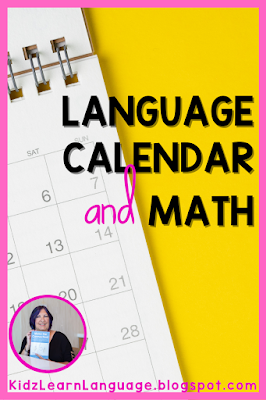As a speech-language pathologist I’ve been known to say, “I do language. I don’t do math.” It’s mostly said tongue cheek, but to be honest, I think it’s too easy to forget that even Math is a language-based activity.
I used to work a lot on word problems with my kids with significant language learning disabilities.
But that’s not really what I’m talking about. The folks at education.com sent me this fun 1st grade calendar math activity, and I accepted the challenge to show just how language based math can be.
Here is the activity plan:
Cut the Calendar
First-grade math includes lots of work with two-digit numbers. Here is a great activity for early in the year, to practice recognizing and sequencing numbers from 1-30.
First-grade math includes lots of work with two-digit numbers. Here is a great activity for early in the year, to practice recognizing and sequencing numbers from 1-30.
What You Need:
• An old calendar
• Child-safe scissors
• Envelope
What You Do:
1 Ask your child if he knows how many days are in a month. Let him flip through the calendar and explore the answer to this question. Point out that a month can have as few as 28 days, or as many as 31.
2 Cut the calendar apart into individual squares with dates on them. Mix the cards and spread them out in front of your child.
3 Start by having your kid put the numbers in order from least to greatest. If she has trouble with this, flip to another page in the calendar and have her match the number cards to the numbers on the calendar.
4 Help your child arrange the cards in the following ways:
• single-digit numbers (1-9) and two-digit numbers (10-30)
• numbers with ones, (such as 1, 11, 21); a number with twos, etc.
• numbers with a one in the tens place (10-19), numbers with a two in the tens place (20-29), and numbers with a three in the tens place (30)
This is a great activity to play again and again, and don’t be surprised if your first-grade teacher uses “calendar math” regularly in class. Keep the calendar pieces in the envelope for further practice anytime.
This activity necessitates listening to and following directions; understanding number sequences; understanding the concepts of least, most, smaller, larger; and knowledge of number and days words.
For many students, just following the steps of an activity can be a challenge. Present the steps of the directions one at a time.
Allow students time to process what you have said. And, if necessary, use visuals to help remind students what you want them to do; in this case, “cut,” and "sort."
The concepts of quantity words can be difficult for many kids. I worked with a teacher at one time who would use gummy bears as a motivator as well as a teaching tool. She would ask students how many they wanted and/or whether they wanted more or less.
I would often see students choose “less” because they just didn’t understand the concept.
With your calendar days cut apart, make piles of the individual day squares. Which pile has the most? Which has the least? When do they look equal; or the same?
Greater than and less than are also difficult concepts for many kids. Here is a good time to work on those concepts. Does a week have more days than a month? Are two weeks’ worth of days a reader pile than one week? Are they greater or less than a pile of the whole month?
How many is two days? what does 2 mean? Work on number words not just by counting the days in sequence, but also by having students identify the number of days in a given “pile.”
You can work on sequencing. The days of the week always come in the same order. Can your students sequence the days by name? Sequencing the order of the days and months can be just as important as sequencing their numbers.
There are many tie-ins from ELA to Math. Math - like all academic subjects - requires a good understanding of the vocabulary and concepts involved. Here are a couple of sorting mats I’ve created to go with this activity, to give you a start.
You might want to go check out my Vocabulary and Concepts for Math resource, found here in my TPT store. It includes interactive books, task cards, printables and activities for concepts of quantity and location, shape and size.
Here are a few samples of what you'll find.
And, “Thank you,” to the folks at education.com for sending along the fun ideas. You can keep kids busy this summer with fun worksheets on rainy days and interesting activities you can take outdoors.*





No comments
Post a Comment